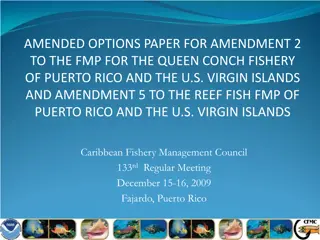Enhancing Catch Quality in Barents Sea Bottom Trawl Fishery
This study aims to investigate the impact of operational procedures on catch quality in the Barents Sea bottom trawl fishery for cod. It includes assessing the effects of prolonged buffer towing, excessive fish exclusion devices, and utilizing a new codend design with an inverse hydrostatic release mechanism. The research intends to improve catch quality by optimizing trawl components and operational methods.
Download Presentation

Please find below an Image/Link to download the presentation.
The content on the website is provided AS IS for your information and personal use only. It may not be sold, licensed, or shared on other websites without obtaining consent from the author. Download presentation by click this link. If you encounter any issues during the download, it is possible that the publisher has removed the file from their server.
E N D
Presentation Transcript
The effect of operational procedures on the catch quality in the Barents Sea bottom trawl fishery for cod (Gadus morhua) Jesse Brinkhof 14.09.2016
Introduction 3-year PhD-position Employed at the Norwegian College of Fishery Science, University of Troms The main objective: To document the effect of various trawl components as well as operational procedures, with the aim of improving the quality of the catch caught by Norwegian bottom trawlers in the Barents sea 2 14.09.2016
Study I: Assessing the impact of prolonged buffer towing on the quality of the catch Prolonged buffer towing (towing the trawl in the water column) is a method used for securing a constant supply of fish to the onboard factory. However, this practice is believed to have negative consequences on the quality of the catch. Trails will be conducted onboard R/V Helmer Hanssen during November 2016. 3 14.09.2016
Study II: Documenting the effect of excessive fish exclusion devices (ExFED) on the catch quality Comparing the quality of the catch caught with and without the use of a ExFED. The ExFED limits the expansion of the catch during haul-back, and is thus believed to increase the amount of damage to the catch, with subsequent reduction in quality. Source: IMR 4 14.09.2016
Study III: Improving the catch quality using a haul- back codend opened at depth with a inverse hydrostatic release mechanism The lack of expansion possibility when using a ExFED, as well as hauling the catch directly onboard are believed to cause damage to the catch with subsequent reduction in catch quality. Therefore, an new codend will be designed with the purpose of preserving the catch quality by reducing the mechanic pressure during haul-back. The codend will be opened during haul-back using a inverse hydrostatic release mechanism, resulting in additional space for expansion as well as reduction in exposure to gravity while hauling up the slipway. 5 14.09.2016























